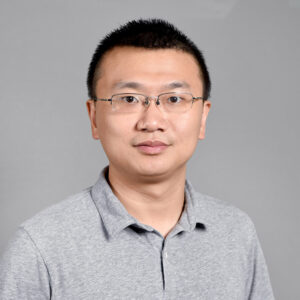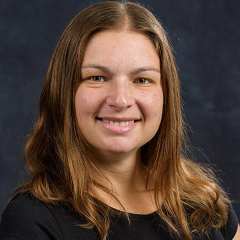CHARTing a course for human-robot solutions
By Oliver Dean
November 15, 2023

Redefining how robots and humans work together — from developing and deploying technologies, to the management and evaluation of human, AI and robot teams — is what Arizona State University’s Center for Human, Artificial Intelligence, and Robot Teaming (CHART) is all about.
Their researchers are leveraging the science of teaming to determine how we can make this new technology human centered, and how it can be applied to our work, play, education and daily lives. CHART has been expanding its impact in many fields, including looking to the future of space exploration and empowering the U.S. Space Force.
The unspoken heroes of this multidisciplinary center play an active role in furthering the mission and goals of the center, and it’s the range and diversity of their work that underpin the foundational science of CHART.
“We focus on bringing together a wide range of affiliates from different disciplines, opening people’s eyes to the fact that this kind of research exists,” says Professor Nancy Cooke, director of CHART. “Our affiliates bring all of the necessary pieces of the problem to the table, working as a team to try to understand how to design these new technologies in the best way possible that takes into account not just what humans want and need, but what the technology’s capable of.”
We spoke with some of CHART’s valued affiliates and learned how their research brings critical impact to the university.
Wenlong Zhang: Cross-disciplinary research drives real-world impact
 ASU’s General Human Operation of Systems as Teams (GHOST) Lab is a state-of-the-art scientific test bed that is also an art installation. Researchers in the lab examine people’s ability to work with robots and AI in scenarios such as a life-threatening meteor strike on a lunar colony.
ASU’s General Human Operation of Systems as Teams (GHOST) Lab is a state-of-the-art scientific test bed that is also an art installation. Researchers in the lab examine people’s ability to work with robots and AI in scenarios such as a life-threatening meteor strike on a lunar colony.
Among those researchers is CHART affiliate Wenlong Zhang, an associate professor in the School of Manufacturing Systems and Networks at ASU’s Ira A. Fulton Schools of Engineering. Zhang’s research interests lie in the design, modeling and control of cyber-physical systems, with applications to health care, robotics and manufacturing.
“When we started discussions of the lab, we wanted to be able to create a space that could help us prepare for future space exploration and simultaneously be a space to simulate a group of soldiers working with next-generation army combat vehicles,” Zhang said.
Zhang contributed to two of the strategic decision-making efforts at the GHOST Lab.
“First and foremost is the importance of interdisciplinary research that encourages our students to think outside their field and talk to others with different expertise, making the end result more impactful. Secondly, mission-driven agencies care about the application of our research. We have to make sure we incorporate the end user in our research, and the GHOST Lab quite literally enables us to achieve this.”
RELATED: Learn more about the GHOST Lab
Joining CHART’s multi-talented team of affiliates, Zhang was thrilled to work alongside Cooke and Associate Professor Erin Chou as they explored subjects such as trust in human-robot interaction. The challenges Zhang and the researchers at CHART face are so complex that it requires more than one discipline to ensure that their research has a successful impact.
“We are asking the question: How can you really design the robots to be trustworthy? And this requires a multidisciplinary approach.”
Rakibul Hasan: Data privacy is just as important as security
 Moving from Bangladesh to the United States was a big step for Rakibul Hasan, and the big leaps in his exciting career did not stop there. Working as a software engineer, he began his PhD at Indiana University Bloomington, where he discovered he could make a positive impact on usable security and privacy.
Moving from Bangladesh to the United States was a big step for Rakibul Hasan, and the big leaps in his exciting career did not stop there. Working as a software engineer, he began his PhD at Indiana University Bloomington, where he discovered he could make a positive impact on usable security and privacy.
During his PhD, Hasan worked on a visual data privacy project involving protecting the identities of bystanders in shared images or videos on social media. Using the findings of their research, he is now working on creating an app that will enable users to protect other people’s privacy when posting content online. The next stop on his career path led him to Arizona State University — known for its security research and wide range of related courses — where he serves as an assistant professor in the School of Computing and Augmented Intelligence.
As a privacy researcher, Hasan believes that data privacy is just as important as security.
“I try to understand the problem space from the user, from the actual people who will be using the system, to know their perspectives, and then identify usable fixes and implement them,” Hasan said. “Joining CHART appealed to me because we use so many techniques — from psychological and internet measurement methods to machine learning and artificial intelligence — to create real-world solutions.”
Hasan is currently working on an exciting project on the intersection of privacy and disinformation. The project is looking into how we can truly understand what drives people to believe or not believe misinformation and how consumption habits can affect their belief interest bases.
“One finding we had was that people who follow online sources had different results compared to those who use more traditional sources, like print or television. The first group are more likely to believe misleading misinformation,” he said.
“We also found that the more surprised people are once they have read an article of news, the less likely they are to believe it, but more likely to share with others, which was very surprising.”
Naturally, joining CHART’s multidisciplinary team made sense, and Hasan was able to fill the data privacy gap, learning from his colleagues as they collaborate on impactful projects together.
Pooyan Fazli: ‘We are stronger under CHART’s umbrella’
 Despite impressive advances to date, one of CHART’s main focus areas, human-robot teaming, has yet to achieve the goal of general-purpose robots that act alongside humans in the real world. Introducing algorithms that will accelerate the transition of robots out of the research lab and into long-term deployment is the focus of affiliate Pooyan Fazli.
Despite impressive advances to date, one of CHART’s main focus areas, human-robot teaming, has yet to achieve the goal of general-purpose robots that act alongside humans in the real world. Introducing algorithms that will accelerate the transition of robots out of the research lab and into long-term deployment is the focus of affiliate Pooyan Fazli.
“My long-term goal is to facilitate the coordination, communication, coexistence, and mutual adaptation between robots and humans in dynamic, uncertain, adversarial and multigoal environments,” Fazli said.
Fazli received his PhD in computer science from the University of British Columbia and now serves as an assistant professor at ASU in the School of Arts Media and Engineering.
“The chance to collaborate with other fellow affiliates who share these same interests is an exciting opportunity for me. I believe that together, we are stronger under CHART’s umbrella,” he said.
Building the next generation of computer scientists and engineers has been the biggest source of pride in Fazli’s career.
“Mentoring my students in their research and career development gives me such joy. Seeing them progress and create fantastic research in my lab — nothing gives me greater satisfaction.”
Another avenue of Fazli’s research is applying artificial intelligence for good by collaborating with other disciplines to tackle critical social, environmental and health challenges. Fazli is currently leading a project that has brought together a team of interdisciplinary researchers with the goal of developing AI-driven systems to enhance video accessibility for blind and low-vision (BLV) individuals. With vast portions of critical information living in video format, accessing it can be a challenge to the approximately 12 million Americans who are diagnosed with visual impairment.
“Our ultimate vision is a future in which BLV individuals can access the information in virtually any online video. Long term, we want to develop an automated system capable of understanding the content of online videos and communicating this information easily.”
Heather Lum: Applying human-dog communication to teaming research
 For many years, humans have been relying on dogs for their special capabilities, such as their ability to smell and hear things beyond human perception. However, while they may outperform humans at some things, there is the inevitable complication of interaction without natural language-based communication.
For many years, humans have been relying on dogs for their special capabilities, such as their ability to smell and hear things beyond human perception. However, while they may outperform humans at some things, there is the inevitable complication of interaction without natural language-based communication.
This fascinating challenge is one area of research for affiliate Heather Lum, assistant professor in human systems engineering at ASU’s Polytechnic School.
“You have to be aware of what the dog is telling you. If not, you cannot be an effective teammate,” Lum said. “We teach the dogs to have purposeful disobedience when it has information we do not yet know. This comes back to human-robot teaming — what are we going to do when a robot is disobedient for a beneficial purpose to the team?”
Lum has a personal stake in this subject in addition to the research she conducts, as she is a canine handler for two search-and-rescue dogs trained to find missing deceased people.
“I see the challenges in the way that we have to understand each other and what I have to do to be an effective team member, while my dogs have to understand the cues I am telling them.”
This summer, Lum participated in a three-month summer faculty fellowship at the Wright Patterson Air Force Base, researching and interviewing about the idea of teaming and how we can do this more effectively.
Lum also explores human factors psychology with an emphasis on human-technology interactions. She joined ASU CHART from Embry-Riddle Aeronautical University with high hopes of connecting her exciting research interests to the work of the other affiliates who are doing similar work in the field of human-robot teaming.
“Being at such a prestigious university that has other faculty in similar fields is amazing. … Bouncing ideas off each other and interacting with others who share similar areas of focus is wonderful.”
ASU’s Global Security Initiative is partially supported by Arizona’s Technology and Research Initiative Fund (TRIF). TRIF investment has enabled hands-on training for tens of thousands of students across Arizona’s universities, thousands of scientific discoveries and patented technologies, and hundreds of new startup companies. Publicly supported through voter approval, TRIF is an essential resource for growing Arizona’s economy and providing opportunities for Arizona residents to work, learn and thrive.
Fulton
Researchers
Nancy Cooke
Professor
The Polytechnic School
Wenlong Zhang
Associate Professor
School of Manufacturing Systems and Networks
Rakibul Hasan
Assistant Professor
School of Computing and Augmented Intelligence
Pooyan Fazli
Assistant Professor
School of Arts, Media and Engineering
Heather Lum
Assistant Professor
The Polytechnic School
Related Stories
Stabenfeldt elected president of Society For Biomaterials
ASU biomedical engineering professor Sarah Stabenfeldt has been elected president of the Society for Biomaterials
ISTB12 to be major economic boost in region
ASU’s 2025 manufacturing engineering building will be “a showcase of what manufacturing is,” with high-tech labs, classrooms, and makerspaces.
Celebrating an excellent microelectronics professor
ASU researcher Sule Ozev received the Joseph C. Palais Distinguished Faculty Scholar Award for her innovative research, teaching and service to the ASU community
ASU creates hub of coursework for careers in booming microelectronics industry
ASU’s new Microelectronics Workforce Development Hub offers more than 70 courses for all ages of people wanting to train for a new career.


